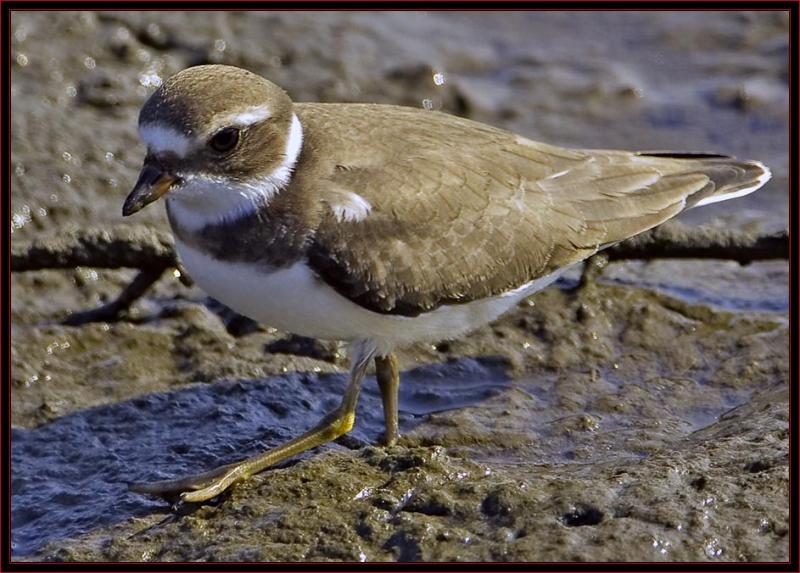Shorebird season
A soft plaintive “puwee” echoed in from out over the water as a small group of swift-winged birds, a tad smaller than robins, came zipping in to land on the shore. With their mud-brown backs and crisp white undersides, stubby bills, and orangey legs, these semipalmated plovers are, as one fellow birder recently said, “well put-together birds.”
When you see one yourself you will know what she meant – the semipalmated plover is a neat and attractive looking birds.
Plovers and their cousins the sandpipers (which include yellowlegs, whimbrels, knots, and others) are collectively referred to by birders as shorebirds. To the uninitiated, any bird that inhabits the shore is, of course, a shore bird, so many lump in the herons, egrets, ducks, gulls, and other birds seen along the shore.
But to birders, the term is restricted only to a species of plover or sandpiper, even though some of the so-called shorebirds may not occur commonly in marine shorelines – and some spend most of their time away from shores of any kind.
For example, upland sandpipers nest in grasslands across the U.S. and winter in grasslands of southern South America, where they are joined by American golden plovers.
The killdeer, a larger look-alike to the semipalmated plover but with two black breast bands rather than one, commonly nests throughout Maine, laying its three to four eggs directly on the ground in barren areas. Often, these areas are gravel driveways or parking lots where the birds can be seen trying to lure away intruders by dragging a wing as if injured – a behavior which probably works better on a fox than a human.
Most of the several dozen or so species of shorebirds that can be seen in Maine pass through only as migrants on their way north to and south from their arctic or subarctic breeding grounds.
In spring, the adults tend to pass through quickly so they can reach their destination and begin nesting as soon as conditions permit. They lay only a single clutch, and the young are born fully feathered and ready to feed themselves immediately. The parents – usually just the female – will warm them and shield them from rain and snow and attempt to drive away predators, but the young are mobile and must feed themselves.
Amazingly, after the young are able to fly the adults leave them and migrate south, some arriving in our area by July. The young continue feeding and learning on their own. Then following some built-in mental directive, they begin flying south without any knowledge of where they are headed.
These young birds, like the semipalmated plovers we saw last week, can be identified based on plumage features like their crisp new-looking plumage and light-edgings to feathers on their backs and parts of the wings.
Especially to beginner bird enthusiasts but also to some more advanced birders, looking at shorebirds is frustrating, even – must we say it? – boring! But if you take the time, shorebirding is extremely enjoyable and rewarding.
They may at first all look very much alike, but with a decent birding telescope or a careful, close approach with binoculars and a little time, you’ll see the beauty and intricacies of the feathers on individual birds. Hopefully, you’ll be hooked and start looking forward to the excitement that end-of-summer birding presents.
Fortunately, the Boothbay area has many good places to look for shorebirds: mud flats and other places where birds feed during low tide or places they can rest undisturbed at high tide. The estuary area visible from the Boothbay Region Land Trust’s Oven’s Mouth Preserve and the salt marsh at the Zak Preserve are a few of the good places to look for shorebirds around Boothbay.
Farther afield, check out Weskeag Marsh in Thomaston, Scarborough Marsh and nearby Pine Point, and Biddeford Pool or Maquoit Bay in Brunswick for chances to see lots of shorebirds.
Dr. Jeff Wells is the senior scientist for the Boreal Songbird Initiative. During his time at the famed Cornell Lab of Ornithology and as the Audubon Society's national bird conservation director, Dr. Wells earned a reputation as one of the nation's leading bird experts and conservation biologists. Jeff's grandfather, the late John Chase, was a columnist for the Boothbay Register for many years. Allison Childs Wells, also formerly of the Cornell Lab of Ornithology, is a widely published natural history writer and a senior director at the Natural Resources Council of Maine. Together, they have been writing and teaching people about birds for decades. The Maine natives are authors of the highly acclaimed book, “Maine's Favorite Birds.”
Event Date
Address
United States

























